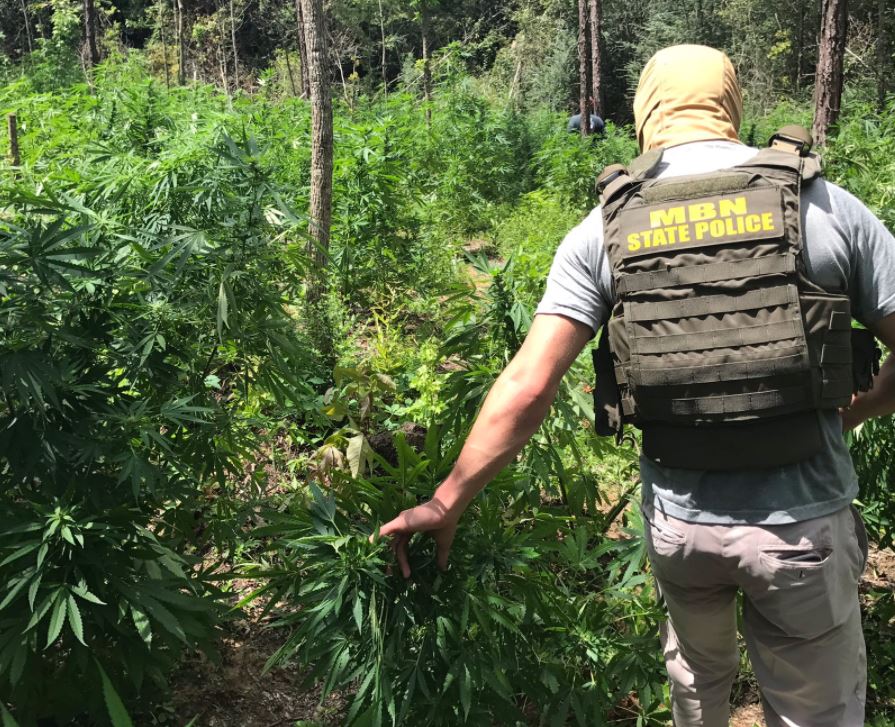Ron Strider
Well-Known Member
It's a massive crime scene, deep in Lassen National Forest.
Through dense ground cover and brutal terrain, federal agents are making their way to what might well qualify as an industrial-scale farm operation, CBS San Francisco reported. There are living quarters, kitchens, bathrooms and trash dumps – all for the purpose of growing a lot of marijuana.
"This one was in excess of 15,000 plants," said Stephen Frick, a special agent with the U.S. Forest Service.
A plant count that high requires multiple plots, across several miles, fed by an endless network of pipes, all drawing right from natural waterways. Scattered over all of this, there are the chemicals. In every single direction there are fertilizers, poisons, and insecticides.
"The malathion, the pesticides a lot of the over the counter stuff, those are pretty common," says Frick. "The uncommon ones are the restricted use pesticides like the carbofuran."
Carbofuran, an extremely toxic pesticide that's effectively banned in the United States, is fast becoming a favorite tool among Mexican drug cartels, which operate in California's public lands. Once a rare find, it's now turning up at 60 to 70 percent of illegal grow sites, often mixed in bottles that have no warning label.
"A mountain biker, a hiker, a child, could be hiking out here, find this and think it's a full bottle of vitamin water," explained Dr. Mourad Gabriel, field agent for the Integral Ecology Research Center. "An eighth of a teaspoon would kill a 300 pound black bear."
That is exactly what is happening.
Illegal growers aren't just using carbofuran as an insecticide, they're using it to kill anything that wanders into their grow sites.
"If you want to kill wildlife, then let's just go ahead and place poison in food and have wildlife come," Gabriel said.
Bears that were photographed walking into camps contaminated with carbofuran were subsequently found dead, and agents are now routinely finding dead wildlife near grows, with testing often proving carbofuran to be the killer.
The situation has become so toxic that hazardous materials experts are now involved. They're trying to figure out just how long carbofuran hangs around in our soil and water.
The forest service is now approaching 400 illegal grow sites this year in California. There is no specific designated budget for mitigating the sites, which are increasingly complicated and expensive to resolve with the presence of carbofuran.
The grows are an old problem, but the illegal, pink poison is just a new, lethal twist. The toll it's taking on our public lands is just starting to surface.
As Dr. Gabriel sees it, "the impact to wildlife and fisheries is a whole completely new frontier."

News Moderator: Ron Strider 420 MAGAZINE ®
Full Article: Toxic chemicals killing California wildlife at illegal marijuana grows - CBS News
Contact: CBS Audience Services Info and Feedback
Photo Credit: MBN Investigation
Website: CBS TV Network Primetime, Daytime, Late Night and Classic Television Shows
Through dense ground cover and brutal terrain, federal agents are making their way to what might well qualify as an industrial-scale farm operation, CBS San Francisco reported. There are living quarters, kitchens, bathrooms and trash dumps – all for the purpose of growing a lot of marijuana.
"This one was in excess of 15,000 plants," said Stephen Frick, a special agent with the U.S. Forest Service.
A plant count that high requires multiple plots, across several miles, fed by an endless network of pipes, all drawing right from natural waterways. Scattered over all of this, there are the chemicals. In every single direction there are fertilizers, poisons, and insecticides.
"The malathion, the pesticides a lot of the over the counter stuff, those are pretty common," says Frick. "The uncommon ones are the restricted use pesticides like the carbofuran."
Carbofuran, an extremely toxic pesticide that's effectively banned in the United States, is fast becoming a favorite tool among Mexican drug cartels, which operate in California's public lands. Once a rare find, it's now turning up at 60 to 70 percent of illegal grow sites, often mixed in bottles that have no warning label.
"A mountain biker, a hiker, a child, could be hiking out here, find this and think it's a full bottle of vitamin water," explained Dr. Mourad Gabriel, field agent for the Integral Ecology Research Center. "An eighth of a teaspoon would kill a 300 pound black bear."
That is exactly what is happening.
Illegal growers aren't just using carbofuran as an insecticide, they're using it to kill anything that wanders into their grow sites.
"If you want to kill wildlife, then let's just go ahead and place poison in food and have wildlife come," Gabriel said.
Bears that were photographed walking into camps contaminated with carbofuran were subsequently found dead, and agents are now routinely finding dead wildlife near grows, with testing often proving carbofuran to be the killer.
The situation has become so toxic that hazardous materials experts are now involved. They're trying to figure out just how long carbofuran hangs around in our soil and water.
The forest service is now approaching 400 illegal grow sites this year in California. There is no specific designated budget for mitigating the sites, which are increasingly complicated and expensive to resolve with the presence of carbofuran.
The grows are an old problem, but the illegal, pink poison is just a new, lethal twist. The toll it's taking on our public lands is just starting to surface.
As Dr. Gabriel sees it, "the impact to wildlife and fisheries is a whole completely new frontier."

News Moderator: Ron Strider 420 MAGAZINE ®
Full Article: Toxic chemicals killing California wildlife at illegal marijuana grows - CBS News
Contact: CBS Audience Services Info and Feedback
Photo Credit: MBN Investigation
Website: CBS TV Network Primetime, Daytime, Late Night and Classic Television Shows


